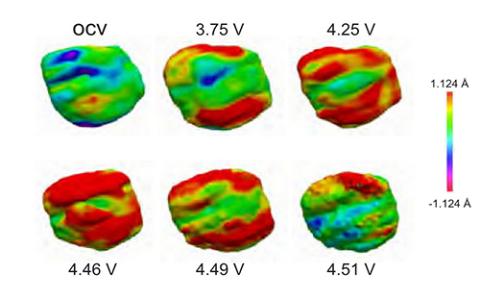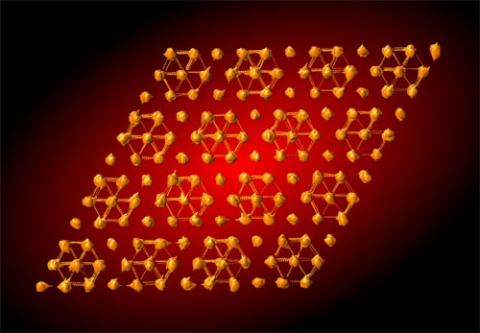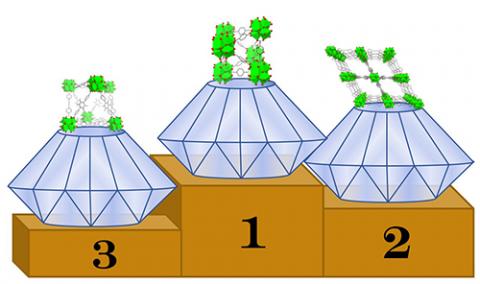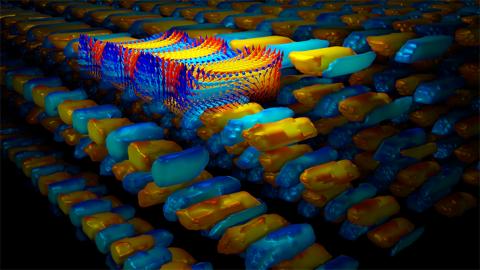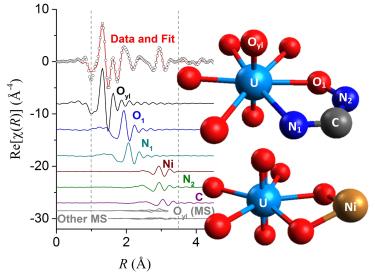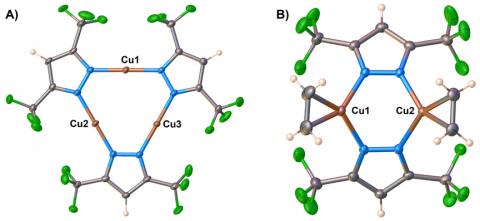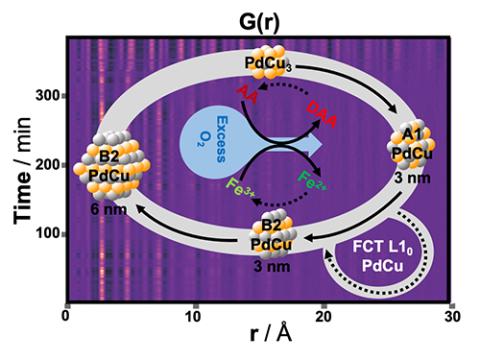New composite materials based on selenium (Se) sulfides that act as the positive electrode in a rechargeable lithium-ion (Li-ion) battery could boost the range of electric vehicles by up to five times, according to groundbreaking research carried out at the U.S. Department of Energy’s Advanced Photon Source at Argonne National Laboratory. The studies of the materials demonstrated that they have the potential to pack five times the energy density of conventional batteries.
SRS Highlights
Recent Research Highlights
Growing the Skinniest Magnets: Experiments performed at the U.S. Department of Energy’s Advanced Photon Source could lead to much smaller, more powerful computers and other magnetic devices.
17-BM-B
Tiny, disordered particles of magnesium chromium oxide may hold the key to new magnesium battery energy storage technology, which could possess increased capacity compared to conventional lithium-ion batteries, find researchers who studied the material utilizing ultra-bright x-ray beams from the U.S. Department of Energy’s Advanced Photon Source.
4-ID-C, 10-BM-A,B, 11-ID-B
A Promising Future-Generation Lithium-Ion Battery Cathode Material: Challenges remain in adapting Li-ion technology for advanced applications because they all require significantly higher energy capacities. Researchers using the U.S. Department of Energy’s Advanced Photon Source investigated a promising alternative cathode material and pinpointed the causes of the differences in performance during charging and discharging.
17-BM-B
Revealing the Source of Degradation in an Advanced Lithium-ion Battery Cathode: The durability of lithium-ion batteries depends highly on the performance of the cathode, the battery's positive electrode. Nanoscale x-ray experiments, carried out at the U.S. Department of Energy’ Advanced Photon Source, are helping scientists develop strategies to mitigate cathode voltage fade, which will result in longer-lasting lithium-ion batteries for electric vehicles and other power storage applications.
9-BM-B,C, 11-ID-C, 34-ID-C
Thin films are ubiquitous in computer chips and other electronic devices. Researchers have recently begun tuning the properties of these films by growing them on substrates with different crystal structures. A particularly interesting case is the lanthanum-cobalt oxide, LaCoO3, or LCO for short. As a bulk crystal, LCO is not magnetic, but thin films of LCO grown on certain substrates exhibit ferromagnetic ordering. Previous attempts to explain this induced magnetism have been unable to incorporate the fact that the atomic arrangement, or crystal symmetry, of epitaxial LCO film is distinct from that of both its bulk phase and its substrates. This symmetry mismatch leads to additional structural distortions in LCO thin films, as observed in x-ray experiments performed at the U.S. Department of Energy’s Advanced Photon Source (APS) and elsewhere.
11-ID-D
A step towards new, "beyond lithium" rechargeable batteries with superior performance has been made by a multi-institution, international collaboration of scientists who used a variety of research techniques and facilities including the U.S. Department of Energy’s Advanced Photon Source (APS) at Argonne National Laboratory. The research was published in the journal Nature Materials.
11-ID-B
Chemical warfare agents that could be deployed against both soldiers and civilians have been a grave concern since World War I, when they were first used. Research on methods to defeat these weapons has been a focus of scientists since that time. Now, a multi-institution collaboration of scientists from U.S. federal research institutions and U.S. universities is studying how the use of zirconium (Zr)-based metal organic frameworks (MOFs) and niobium (Nb)-based polyoxometalates (POMs) may be effectively used in gas masks to capture and decompose dangerous chemical agents like Sarin, notably used in a subway terrorist attack in Japan in 1995.
17-BM-B
A novel gold compound with an “extra” electron compared to its chemical cousins is predicted to be a 3D Dirac semimetal, a relatively new class of electronic materials in which electrons behave as though they are massless, leading to high mobilities and unusual physics. The discovery, made at the U.S. Department of Energy’s Advanced Photon Source (APS), expands the search for possible thermoelectric materials (which make up Peltier coolers and thermoelectric generators) to include compounds with gold-gold bonds that stabilize "abnormal" electron counts. Such materials have very fast-moving electrons that could be used in circuits. Alternatively, these semimetals may have applications for solid-state cooling or heating.
11-BM-B
Metal-organic frameworks (MOFs) are handy crystalline constructs that combine metallic ions with organic molecules to form a structure featuring molecular “cages” or channels that can trap other atoms or molecules to filter, store, or otherwise separate them from the surrounding environment. One common potential use for MOFs is in catalysis, but the immobilization of enzymes is challenging because of leaching and aggregation that can decrease catalytic efficiency. With the help of structural studies performed at the U.S. Department of Energy’s Advanced Photon Source (APS), a group of experimenters has devised several new MOFs designed to encapsulate enzymes with high catalytic efficiency and recyclability. Their work was published in Nature Communications.
17-BM-B
As the world moves away from incandescent light bulbs, light-emitting diodes (LEDs) are growing in popularity. They use significantly less energy and have far longer lifetimes than do the traditional incandescent bulbs, which are being phased out, and they don't contain mercury, as do compact fluorescents. LEDs do have a drawback, however. The phosphors that convert the single color produced by an LED into white light tend to produce a cool, bluish glow instead of the warmer, yellower color most people prefer.
11-BM-B
Inexpensive materials called MOFs, for metal-organic frameworks, pull gases out of air or other mixed gas streams, but fail to do so with oxygen. Now, a team that includes researchers from two U.S. Department of Energy (DOE) national laboratories has overcome this limitation by creating a composite of a MOF and a helper molecule in which the two work in concert to separate oxygen from other gases simply and cheaply. The results, achieved with an assist from the DOE’s Advanced Photon Source (APS) at Argonne, might help with a wide variety of applications, including making pure oxygen for fuel cells, using that oxygen in a fuel cell, removing oxygen in food packaging, making oxygen sensors, or for other industrial processes. The technique might also be used with gases other than oxygen as well by switching out the helper molecule.
11-ID-B
It's All Geometry: Studying How Li-Ion Batteries Shape Up: A team of researchers used the U.S. Department of Energy’s Advanced Photon Source to probe battery materials at the nanoscale and discovered how the geometry of electrode particles could be the key to getting the most out of Li-ion batteries.
6-BM-A,B, 17-BM-B
New research offers the first complete picture of why a promising approach of stuffing more lithium into battery cathodes leads to their failure. A better understanding of this could be the key to smaller phone batteries and electric cars that drive farther between charges.
11-ID-B, 20-BM-B
Researchers using the U.S. Department of Energy’s Advanced Photon Source took a detailed look at high-temperature tantalum behavior to assess its role in potential future superconducting, optoelectronic, and ultrafast electronic devices.
1-ID-B,C,E, 11-ID-C
X-ray experiments at the U.S. Department of Energy’s Advanced Photon Source could help researchers design valuable porous materials for high-pressure applications.
17-BM-B
Portland cement concrete is all around us, in the sidewalks we walk on, the buildings we live and work in, and the roads our vehicles ride on. One of the most versatile and useful building materials ever created, it is so commonplace that we hardly ever think of it (unless we happen to trip and scrape our knees on it). Yet surprisingly, although we worry about carbon emissions from cars, airplanes, and power plants, this everyday, seemingly innocent material is also a hidden and largely ignored global warming culprit.
11-ID-C
"Frustration" plus a pulse of laser light resulted in a stable "supercrystal" created by a team of researchers from two U.S. universities and three U.S. Department of Energy national laboratories, including Argonne National Laboratory.
7-ID-B,C,D, 11-ID-D, 33-BM-C, 33-ID-D,E
Carbon monoxide (CO) is an insidious poison because it loves the iron in our blood; it pushes oxygen out of iron-based hemoglobin, leading to painful asphyxiation. This affinity for iron comes in handy in a newly created material that can absorb carbon monoxide far better than other materials, with potential applications in industrial processes like syngas production, where CO is a key player, and reactions where CO is an unwanted contaminant. A number of characterization and measurement techniques contributed to this groundbreaking research, including critical experiments at the U.S. Department of Energy’s Advanced Photon Source.
11-BM-B, 17-BM-B
Work by a team of researchers from Oak Ridge National Laboratory (ORNL) and The University of Chicago shows that the polymeric adsorbent materials that bind uranium behave nothing like scientists had believed. The results, detailed in a paper published in Energy & Environmental Science, highlight data made possible with x-ray absorption fine structure spectroscopy performed at the Materials Research Collaborative Access Team beamline 10-BM-B at the U.S. Department of Energy’s Advanced Photon Source (APS), as well as pair distribution function data collected at the X-ray Science Division beamline 11-ID-B, also at the APS, which is an Office of Science User Facility at Argonne National Laboratory.
11-ID-B
The rechargeable lithium-ion batteries in our smartphones, laptops, and various other personal electronic devices make them completely portable, allowing us to unplug so long as the batteries are charged. But rechargeable batteries don't last forever, and the more times they're recharged, the less energy they store.
11-ID-B
Even as our electronic devices become ever more sophisticated and versatile, battery technology remains a stubborn bottleneck, preventing the full realization of promising applications such as electric vehicles and power-grid solar energy storage. Among the limitations of current materials are poor ionic and electron transport qualities. While strategies exist to improve these properties, and hence reduce charging times and enhance storage capacity, they are often expensive, difficult to implement on a large scale, and of only limited effectiveness. An alternative solution is the search for new materials with the desired atomic structures and characteristics. This is the strategy of a group of researchers who, utilizing ultra-bright x-rays from the U.S. Department of Energy’s Advanced Photon Source, identified and characterized two niobium tungsten oxide materials that demonstrate much faster charging rates and power output than conventional lithium electrodes.
9-BM-B,C, 17-BM-B
Pivotal Battery Discovery Could Impact Transportation and the Grid: Researchers using the U.S. Department of Energy’s Advanced Photon Source have discovered a key reason for the performance degradation of the sodium-ion battery, a promising low-cost alternative to lithium-ion batteries.
11-ID-C, 20-BM-B
Laser Excitation Alters the Structure and Light Emission of Perovskite Thin Films: Hybrid organic-inorganic perovskites show exceptional promise for use in multiple optoelectronic applications. Research at the U.S. Department of Energy’s Advanced Photon Source produced dramatic results which provide important new insights into the dynamic behavior of these materials, which are being developed for advanced sensors, light-emitting diodes, and photovoltaic devices.
11-ID-D
Researchers Develop a Cobalt-Free Cathode for Lithium-Ion Batteries: Researchers using three U.S. Department of Energy x-ray light source user facilities, including the Advanced Photon Source, have devised a way to make lithium-ion battery cathodes without using cobalt, a mineral plagued by price volatility and geopolitical complications.
7-BM-B, 11-ID-C
Carbon monoxide (CO) is an insidious poison because it loves the iron in our blood; it pushes oxygen out of iron-based hemoglobin, leading to painful asphyxiation. This affinity for iron comes in handy in a newly created material that can absorb carbon monoxide far better than other materials, with potential applications in industrial processes like syngas production, where CO is a key player, and reactions where CO is an unwanted contaminant. A number of characterization and measurement techniques contributed to this groundbreaking research, including critical experiments at the U.S. Department of Energy’s Advanced Photon Source.
11-BM-B, 17-BM-B
Quantum Leap: Advancing High-Temperature Superconductor Research: Researchers have discovered that nickel, a neighbor of copper on the periodic table, can also superconduct as an oxide, but so far only as an atomically thin film. Data collected at the U.S. Department of Energy’s Advanced Photon Source may help explain why these crystals do not superconduct and how they might be coaxed into this exotic quantum state.
6-ID-D, 11-BM-B
Highly intense x-ray beams and a clever experimental setup allowed researchers to watch a high-pressure, high-temperature chemical reaction to determine for the first time what controls formation of two different nanoscale crystalline structures in the metal cobalt. The technique, employed at two U.S. Department of Energy x-ray light sources, including the Advanced Photon Source, allowed continuous study of cobalt nanoparticles as they grew from clusters including 10s of atoms, to crystals as large as 5 nanometers. The research provides the proof-of-principle for a new technique to study crystal formation in real time, with potential applications for other materials, including alloys and oxides.
17-BM-B
Nuclear power is one of the best ways currently available to supply clean, baseload electric power to the U.S. over the long term. But reserves of good uranium ore to fuel those plants are diminishing. By 2100 there will not be enough recoverable uranium left in terrestrial mines to meet the demands of existing power plants. However, if we cannot mine uranium on land, we may be able to sift it from the sea: The oceans contain huge reserves of uranium dissolved in seawater. State-of-the-art polymer fabrics soaked in seawater can recover 7 to 8 grams of uranium over a span of 30 days.
11-ID-B
Developing hydrogen as a fuel is important for both economic and environmental reasons. This work carried out at the U.S. Department of Energy’s Advanced Photon Source advances our understanding of the charge-separation dynamics that occur in bio-inspired photocatalytic systems for the hydrogen evolution reaction.
9-BM-B,C, 11-ID-D
Splitting water using renewable electricity to produce green hydrogen is seen by many as essential for achieving net-zero carbon emissions. A group of scientists has recently demonstrated a new type of low-cost catalyst that could slash the cost and boost the efficiency of green hydrogen production through water splitting.
12-BM-B, 17-BM-B, 20-BM-B
New Pathways to Advance Adsorbent Technologies for Alkene Purification: Research carried out in collaboration with beamline scientists at the U.S. Department of Energy’s Advanced Photon Source have exciting implications for the development of new adsorbent materials that can significantly improve the energy efficiency and carbon footprint of industrial-scale alkene purification processes.
17-BM-B
Ultrafast X-rays Track Charge Flows in a Promising Photovoltaic Material: A class of materials known as lead halide perovskites show remarkable potential for use in optoelectronic applications. Experiments carried out at the U.S. Department of Energy’s Advanced Photon Source should improve the theoretical framework used to describe these materials, thereby hastening their practical use for solar power and other applications.
11-ID-D
A Dramatic Improvement in Li-S Battery Performance Using Lightweight Silica: An appealing variation of lithium-ion batteries is the lithium-sulfur (Li-S) design. The scientists carrying out this research at the U.S. Department of Energy’s Advanced Photon Source are confident their findings will hasten the adoption of Li-S battery technology to meet the demands of a sustainable energy future.
17-BM-B
Of the many amino acids essential for life, glycine has both the fewest number of atoms and the greatest known number of polymorphs (unique structural forms). Although scientists have long recognized that glycine displays multiple polymorphs, the exact structure of several of these forms has remained a mystery. Now a research team has uncovered the precise molecular arrangement of one of these mysterious structural phases, which they have dubbed glycine dihydrate, or GDH. The researchers deduced the structure of GDH by applying computational analysis to powder x-ray diffraction measurements collected at the U.S. Department of Energy’s Advanced Photon Source (APS) at Argonne National Laboratory.
17-BM-B
Humans can learn a lot from plants. With energy from the sun, protein catalysts in plants efficiently split water to generate oxygen, storing the energy as carbohydrates. Scientists would like to perform a similar trick, using solar energy to split water and produce hydrogen fuel. Hydrogen fuel burns clean, producing only water as a byproduct, but splitting water is not an efficient task for humans. Researchers have taken baby steps toward artificial photosynthesis, building solar-powered water-splitting catalysts in the laboratory, but so far these catalysts remain far less efficient than their vegetal counterparts. One reason it's difficult to improve catalytic efficiency is that scientists don't fully understand the catalysts’ water-splitting mechanism.
11-ID-D
Researchers utilizing intense x-ray beams from the U.S. Department of Energy’s Advanced Photon Source (APS) examined the flow of electricity through semiconductors and uncovered another reason these materials seem to lose their ability to carry a charge as they become more densely “doped.” Their results, which may help engineers design faster semiconductors in the future, were published online in the journal ACS Nano.
10-ID-B, 11-ID-D, 12-ID-B
Crystals Could Reveal a New Spin on Quantum Physics: Physicists would like to know whether a theorized new state of matter, called a quantum spin liquid, actually exists. One multi-institution group of researchers, using the U.S. Department of Energy’s Advanced Photon Source at Argonne National Laboratory, thinks they may have found a rare state very similar to a quantum spin liquid.
11-BM-B, 15-ID-B,C,D
Fine-Grained Differences in Polycrystalline Nickel-Rich Li-Ion Battery Cathodes: A team of investigators used the U.S. Department of Energy’s Advanced Photon Source to study a largely overlooked solution to the problem of thermal instability in Li-ion batteries, involving the precise tailoring of grain microstructure in cathode materials.
11-ID-C, 20-BM-B
Just as fishing experts know that casting a line in the right spot hooks the big catch, scientists from the U.S. Department of Energy Office of Science's (DOE-SC's) Ames Laboratory used an algorithm they developed, and the high-brightness x-ray beams from the DOE-SC's Argonne National Laboratory Advanced Photon Source to hone in on just the right spot for discovering a new family of rare-earth quasicrystals.
11-ID-C
Researchers used the U.S. Department of Energy’s Advanced Photon Source to reveal the structural evolution of inorganic cluster growth and crystallization resulting from sequential infiltration synthesis in polymeric templates with potential applications that extend to virtually all technologies in which periodic nanomaterial structures are desirable.
11-ID-B, 20-BM-B
Metal oxides such as titanium dioxide (TiO2) are fascinating and versatile substances that can be used in many applications, including photovoltaic devices, batteries, and other vital technologies. But the utility of a particular material for a particular purpose may be limited, and common techniques to chemically "fine tune" their properties to fit specific parameters, such as doping or surface coating, are not always practical or effective. A group of researchers from a diverse set of institutions decided to try a different strategy by cross-linking metal oxide molecules with boron to create clusters of hybrid networks with new chemical and electrical properties and then characterizing the material at the U.S. Department of Energy’s Advanced Photon Source. Their work, which was published in Nature Materials, opens possibilities for the precise tailoring of such materials for specific purposes.
10-BM-A,B, 11-ID-B
In a new study, researchers from the Cambridge Crystallographic Data Centre (CCDC) and the U.S. Department of Energy’s (DOE’s) Argonne National Laboratory have teamed up to capture neon within a porous crystalline framework. Neon is well known for being the most unreactive element and is a key component in semiconductor manufacturing, but this is the first time neon has ever been studied within an organic or metal-organic framework. The results, which include critical studies at the Advanced Photon Source (APS), a DOE Office of Science user facility at Argonne, also point the way towards a more economical and greener industrial process for neon production.
17-BM-B
Crystallographic evidence of the importance of water loading effects on a metal-organic framework that does not experience large-scale structural changes has been revealed by researchers using the U.S. Department of Energy’s Advanced Photon Source, with the potential for increasing their usefulness in important industrial and even medical applications.
15-ID-B,C,D, 17-BM-B
A New Focus Emerges for Barocaloric Cooling Research: Barocaloric cooling is one of several new technologies promising improved efficiency and reduced emissions. Experiments at the U.S. Department of Energy’s Advanced Photon Source showed that order-disorder transitions of hydrocarbons within the organic bilayers of select two-dimensional metal-halide perovskites can be tuned to achieve colossal barocaloric effects.
17-BM-B
It Pays to Break the Rules When Synthesizing Intermetallic Nanoparticles: Bimetallic intermetallic nanoparticles (NPs) are receiving increased attention because of their proven ability to selectively tune and optimize catalytic processes. By capitalizing on the insights gleaned from studies carried out at two x-ray light sources including the U.S. Department of Energy's Advanced Photon Source, the researchers hope to develop new design principles leading to an expanded library of intermetallic NPs.
11-ID-B
As the lithium-ion industry continues to grow, so does the use of cobalt or nickel, straining scarce metal resources. To sustain this continued growth, development of new cathodes with high energy densities made from Earth-abundant elements will be necessary. Users of the U.S. Department of Energy’s Advanced Photon Source report two new inexpensive lithium-ion cathode materials with extraordinary potential as cathodes in lithium-ion batteries.
11-ID-B, 20-BM-B
As the techniques of additive manufacturing (AM), more popularly known as “3-D printing,” become ever more versatile and applicable for diverse purposes, they sometimes pose unique challenges that are not present with more traditional manufacturing methods. In additive-manufactured metals and alloys, such problems can result in microstructural defects that lead to reduced strength and stress resistance, an issue commonly addressed by post-build heat treatment. But this approach can also have undesirable side effects. Researchers from the National Institute of Standards and Technology used the U.S. Department of Energy’s Advanced Photon Source to examine the AM alloy Inconel 625 (IN625) in an effort to better understand the effects of heat treatment on AM alloy microstructure and phase evolution.
9-ID-B,C, 11-BM-B
Transforming Clean Energy Technology: A breakthrough by researchers using the U.S. Department of Energy’s Advanced Photon Source and Advanced Light Source could eliminate a critical obstacle from the storage and distribution of solar energy, a discovery that represents a giant stride toward a clean-energy future.
17-BM-B, 20-BM-B
A New Cathode Coating to Significantly Improve High-Temperature Performance of Li-Ion Batteries: The exponential growth in the use of li-ion batteries is challenging researchers for designs that are better able to operate stably across regional and seasonable temperature fluctuations, particularly at high temperatures. Researchers using the U.S. Department of Energy’s Advanced Photon Source obtained results that suggest a particular coating can significantly improve the thermal stability of certain cathodes at the bulk level, thus increasing safety and high-temperature operational resiliency.
17-BM-B, 34-ID-C
Chemically the same, graphite and diamonds are as physically distinct as two minerals can be, one opaque and soft, the other translucent and hard. What makes them unique is their differing arrangement of carbon atoms. Polymorphs, or materials with the same composition but different structures, are common in bulk materials. Now a new study in Nature Communications that describes results from studies at synchrotron x-ray light sources, including two U.S. Department of Energy user research facilities, confirms they exist in nanomaterials, too.
11-ID-B





